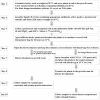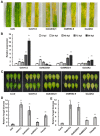An Agrobacterium-Mediated Transient Expression Method for Functional Assay of Genes Promoting Disease in Monocots
- PMID: 37108797
- PMCID: PMC10142106
- DOI: 10.3390/ijms24087636
An Agrobacterium-Mediated Transient Expression Method for Functional Assay of Genes Promoting Disease in Monocots
Abstract
Agrobacterium-mediated transient expression (AMTE) has been widely used for high-throughput assays of gene function in diverse plant species. However, its application in monocots is still limited due to low expression efficiency. Here, by using histochemical staining and a quantitative fluorescence assay of β-glucuronidase (GUS) gene expression, we investigated factors affecting the efficiency of AMTE on intact barley plants. We found prominent variation in GUS expression levels across diverse vectors commonly used for stable transformation and that the vector pCBEP produced the highest expression. Additionally, concurrent treatments of plants with one day of high humidity and two days of darkness following agro-infiltration also significantly increased GUS expression efficiency. We thus established an optimized method for efficient AMTE on barley and further demonstrated its efficiency on wheat and rice plants. We showed that this approach could produce enough proteins suitable for split-luciferase assays of protein-protein interactions on barley leaves. Moreover, we incorporated the AMTE protocol into the functional dissection of a complex biological process such as plant disease. Based on our previous research, we used the pCBEP vector to construct a full-length cDNA library of genes upregulated during the early stage of rice blast disease. A subsequent screen of the library by AMTE identified 15 candidate genes (out of ~2000 clones) promoting blast disease on barley plants. Four identified genes encode chloroplast-related proteins: OsNYC3, OsNUDX21, OsMRS2-9, and OsAk2. These genes were induced during rice blast disease; however, constitutive overexpression of these genes conferred enhanced disease susceptibility to Colletotrichum higginsianum in Arabidopsis. These observations highlight the power of the optimized AMTE approach on monocots as an effective tool for facilitating functional assays of genes mediating complex processes such as plant-microbe interactions.
Keywords: Agrobacteria-mediated transient expression; Arabidopsis; barley; chloroplast; functional screening; gain-of-function; protein-protein interaction; rice blast disease; susceptibility.
Conflict of interest statement
No conflict of interest were declared.
Figures






Similar articles
-
An improved and efficient method of Agrobacterium syringe infiltration for transient transformation and its application in the elucidation of gene function in poplar.BMC Plant Biol. 2021 Jan 21;21(1):54. doi: 10.1186/s12870-021-02833-w. BMC Plant Biol. 2021. PMID: 33478390 Free PMC article.
-
An efficient Agrobacterium-mediated transient transformation of Arabidopsis.Plant J. 2012 Feb;69(4):713-9. doi: 10.1111/j.1365-313X.2011.04819.x. Epub 2011 Nov 17. Plant J. 2012. PMID: 22004025
-
Optimization of conditions for transient Agrobacterium-mediated gene expression assays in Arabidopsis.Plant Cell Rep. 2009 Aug;28(8):1159-67. doi: 10.1007/s00299-009-0717-z. Epub 2009 May 30. Plant Cell Rep. 2009. PMID: 19484242
-
Protoplast isolation, transient transformation of leaf mesophyll protoplasts and improved Agrobacterium-mediated leaf disc infiltration of Phaseolus vulgaris: tools for rapid gene expression analysis.BMC Biotechnol. 2016 Jun 24;16(1):53. doi: 10.1186/s12896-016-0283-8. BMC Biotechnol. 2016. PMID: 27342637 Free PMC article.
-
Transient Gene Expression is an Effective Experimental Tool for the Research into the Fine Mechanisms of Plant Gene Function: Advantages, Limitations, and Solutions.Plants (Basel). 2020 Sep 11;9(9):1187. doi: 10.3390/plants9091187. Plants (Basel). 2020. PMID: 32933006 Free PMC article. Review.
Cited by
-
A Puccinia striiformis f. sp. tritici Effector with DPBB Domain Suppresses Wheat Defense.Plants (Basel). 2025 Feb 2;14(3):435. doi: 10.3390/plants14030435. Plants (Basel). 2025. PMID: 39942997 Free PMC article.
-
Improved Protocol for Efficient Agrobacterium-Mediated Transient Gene Expression in Medicago sativa L.Plants (Basel). 2024 Oct 26;13(21):2992. doi: 10.3390/plants13212992. Plants (Basel). 2024. PMID: 39519910 Free PMC article.
-
Verifying Plasmid Constructs via Transient Agrobacterium tumefaciens-Mediated Plant Transformation in Nicotiana benthamiana.Methods Mol Biol. 2025;2911:21-36. doi: 10.1007/978-1-0716-4450-8_4. Methods Mol Biol. 2025. PMID: 40146507
References
-
- Zhang Y., Chen M., Siemiatkowska B., Toleco M.R., Jing Y., Strotmann V., Zhang J., Stahl Y., Fernie A.R. A highly efficient Agrobacterium-mediated method for transient gene expression and functional studies in multiple plant species. Plant Commun. 2020;1:100028. doi: 10.1016/j.xplc.2020.100028. - DOI - PMC - PubMed
-
- Chang Q.-L., Xu H.-J., Peng Y.-L., Fan J. Subtractive hybridization-assisted screening and characterization of genes involved in the rice-Magnaporthe oryzae interaction. Phytopathol. Res. 2019;1:21. doi: 10.1186/s42483-019-0027-5. - DOI
MeSH terms
Substances
Grants and funding
LinkOut - more resources
Full Text Sources
Research Materials

